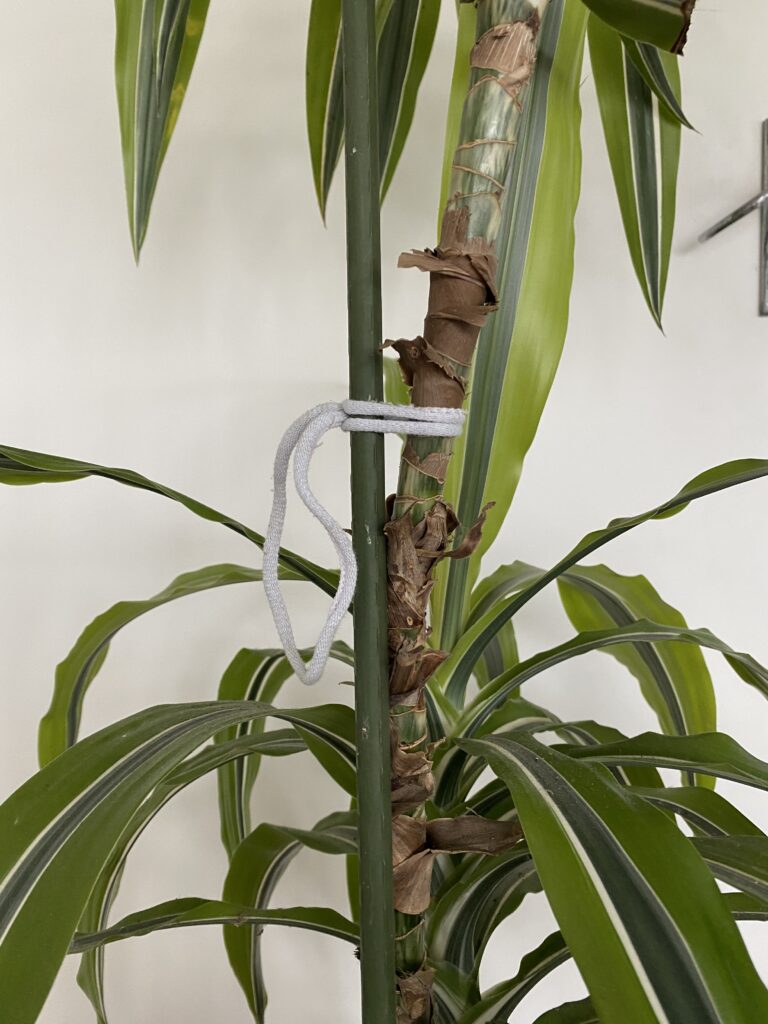Staking Houseplants: Supporting Rubber Plants, Fiddle Leaf Figs, and Monstera
Houseplants bring natural beauty indoors, but as larger plants grow, they often become top-heavy, leading to leaning or bending. Staking is essential for keeping plants like rubber plants, fiddle leaf figs, and monstera upright, promoting healthy growth and preventing damage. In this guide, we’ll cover how to stake these popular plants effectively, including why cloth ties, like eco Ties, are a great choice for securing plants as the plant grows.
Why Stake Your Houseplants?
Indoor plants often lack natural support and may become unstable as they grow. Staking provides essential stability, helping plants grow upright, reducing leaning, and improving airflow, which helps prevent disease. For tall or sprawling plants like rubber plants, fiddle leaf figs, and monstera, staking can encourage vertical growth, creating a fuller, more structured look.

Step 1: Choosing Your Stake
Select a stake that’s durable yet blends well with the plant.
– Bamboo stakes are preferred as they’re natural, sturdy, and visually unobtrusive.
– Plastic coated metal stakes are much sturdier and may be required if the plant grows larger.
It’s easy to replace the stake at a later date, but make sure the stake is big enough to support some growth.
Step 2: Positioning the Stake
Position the stake about 2-3cm from the main stem, carefully pressing it into the soil without disturbing the roots. This provides a strong foundation for the plant to lean on as it grows. If you’re staking a plant with multiple stems, like a monstera, you may need two or more stakes.
Step 3: Securing the Plant to the Stake
Use flexible, soft ties to avoid damaging the stems. eco Ties are ideal for this purpose, as they’re stretchy cloth ties that expand with the plant’s growth, reducing the risk of injury to the stem. To attach, wrap the eco Tie loosely around both the plant and stake, creating a figure-eight shape for added stability without constriction. Start near the base and add ties every few inches along the main stem, depending on the plant’s height.
Staking Tips for Specific Plants
Rubber Plants (Ficus elastica)
Rubber plants grow tall but have relatively weak stems in the early stages, making staking helpful for creating an upright, tree-like structure – with healthy growth, staking later may be uncessary.
Place the bamboo stake close to the main stem and secure it with 1 or 2 eco Ties depending on the height of the stem. This will help maintain height without sagging or bending.
Fiddle Leaf Fig (Ficus lyrata)
Known for their large, heavy leaves, fiddle leaf figs often become top-heavy, especially as they grow taller. Staking can prevent tipping by supporting the main stem and reduce any unwanted kinks.
Use 1-2 ties, spread approximately 25-30cm apart to allow new growth to flourish.
Remember to regularly prune your Fiddle Leaf Fig to encourage bushier growth & unnecessary height.
Monstera (Monstera deliciosa)
Monstera are natural climbers and benefit greatly from staking, allowing them to grow upright while their aerial roots attach to the stake for extra support.
Insert the stake centrally in the pot and use ties to secure the main stems. This encourages vertical growth, letting the plant’s dramatic foliage shine.
As the plant begins to sprawl you may need a larger stake to keep the new growth upright and we recommend using tying two ties together to give enough the plants enough flexibility.

Maintaining Your Staked Plants
As your plants grow, check your ties periodically to ensure they’re not too tight. Plants expand over time, and our ties are easily adjusted to account for that. Keeping ties loose enough to allow for slight movement will also help the plant develop a strong structure is the main objective.
Final Thoughts
Staking can make a big difference for large indoor plants like rubber plants, fiddle leaf figs, and monstera, promoting upright growth and preventing damage. By using natural bamboo stakes and flexible eco Ties, you can support your plants gently and effectively. The stretchy fabric of eco Ties expands with the plant, making them an excellent choice for long-term support. With these simple steps, your plants can grow taller and stay healthy for years to come.
Adding staking to your plant care routine ensures that your plants remain stable, enhancing both their beauty and longevity as they flourish indoors.



